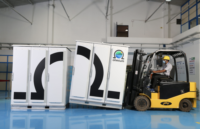Canada is revving up investment in green hydrogen, with two planned megaproject deals announced since late last month on both sides of the nation—as it seeks to source 30% of its energy from the fuel by 2050, up from nearly zero now. The plan is to rely on abundant hydroelectric power and construction of new clean energy sources.
Montreal-based TES Canada H2 Inc. announced Nov. 9 it will build a $2.9-billion green hydrogen project, Projet Mauricie, which it said would produce 70,000 tons annually by 2028. The company said one-third of the generated hydrogen will target decarbonization of long-haul transportation, while the rest will produce renewable natural gas (e-NG) for hard-to-abate industries. The synthetic gas is produced from renewable hydrogen and carbon dioxide.
Fueling the project will be a company-developed 1-GW wind and solar farm on a site north of Montreal that will minimize energy used from utility Hydro-Québec’s grid, TES Canada H2 said. In addition, it will build an electrolyzer for hydrogen production, also located in Quebec’s so-called Energy Transition Valley.
The project is financed 60% by TES Canada H2’s Belgium-based parent, Tree Energy Solutions, and 40% by a fund controlled by the wealthy Desmarais family in Canada.
In its 2023 budget, Canada introduced a $12.8-billion tax credit for such projects to help companies make one-time capital expenditures. But legislators say they want future budgets to include production tax credits for electricity, batteries and clean hydrogen.
“The economic spinoffs will be significant for ... the region, and will position Québec as a leader in decarbonization,” said Eric Gauthier, TES Canada H2 general manager, in the firm announcement. More than 1,000 construction jobs 200 permanent ones are anticipated.
However, a Quebec energy ministry spokesperson said it “has not granted any funding” for the Projet Mauricie electrolyzer.
Tree Energy Solutions, launched in 2019, also has stated plans to build large-scale green hydrogen projects in Australia, Europe, the Middle East, Asia and the U.S. It announced in May a partnership with French giant TotalEnergies to pursue development of a large-scale U.S. production unit for e-natural gas, estimated to produce 100,000 to 200,000 metric tons per year.
No project location was disclosed, but the companies aim to reach a final investment decision in 2024 and could use tax credits under the 2022 Inflation Reduction Act.
Critics of the fuel worry about methane leakage risks in production and its cost competitiveness to reach climate targets, according to Financial Times. But Tree Energy Solutions CEO Marco Alverà said falling electrolyzer costs will enable e-natural gas to become "cheaper than oil.”
Indigenous Land Hub
Meanwhile, British Columbia and the McLeod Lake Indian Band signed a formal agreement last month to develop an “energy transition hub” on indigenous land in the province’s northern area, set to include up to $7 billion of proposed projects the band has been exploring with international investors.
When fully developed, the hub "will be one of the largest Indigenous energy projects in the country,” said B.C. Premier David Eby. “It has the potential to generate significant green hydrogen to decarbonize industry in British Columbia.”
The band said it aims to build a $3.6-billion hydrogen production facility to reduce emissions in hard-to-decarbonize industries and has been in talks with Mitsubishi Power Americas, which has built similar projects in Japan and Spain.
The facility will store carbon dioxide emitted from production of green hydrogen derived from non-fossil-fuel sources and blue hydrogen made from natural gas.
“We finally have a credible partner in Mitsubishi and are looking forward to concluding an agreement in the next 12 to 18 months,” said McLeod Lake Chief Harley Chingee.
A second proposed project is a straddle plant that would extract high-value natural-gas liquids otherwise burned as byproducts in the gas distribution system.
Chingee pointed to a site about 80 to 90 km north of Prince George, B.C., that has hydroelectricity, rail and a major highway “all within proximity of the energy hub.” The site also is near the newly completed $14-billion Coastal Gaslink pipeline that will carry natural gas to a Pacific coast export terminal.
He added that McLeod Lake Indian Band will negotiate an estimated 30% to 33% ownership stake in the hub once Mitsubishi Power makes a final investment decision, anticipated next fall.
Expected to create up to 2,000 construction jobs and 500 permanent jobs, the project is not now government-funded.
Canada has more than 100 hydrogen and fuel-cell tech companies, with one, Ontario-based GH Power Inc., recently announcing a new 2-MW hydrogen reactor that it says can create hydrogen, alumina (aluminum oxide) and exothermic heat, with zero emissions, zero carbon and zero waste.
The reactor is designed to be modular and scalable even in remote areas, the firm said, adding that second-phase testing began in June.
"Revenue generation is forecast to begin in the fourth quarter, and then the future is all about scaling up from 2-MW reactors to a 27-MW net output power solution," GH Power said.






Post a comment to this article
Report Abusive Comment